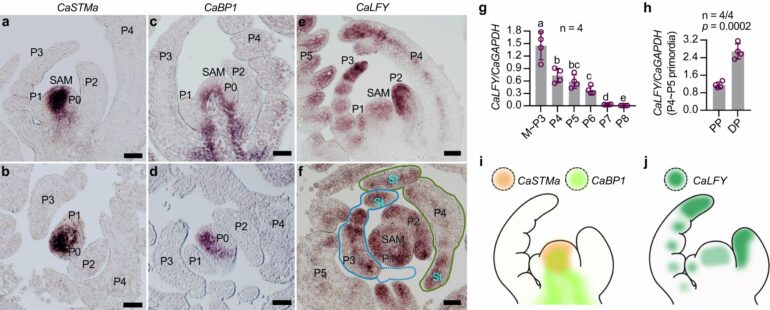Compound leaves, which are composed of multiple independent units called leaflets, show a wide diversity of patterning, ranging from trifoliolate, palmate, pinnate to higher ordered forms. There is agreement that the proximodistal expression patterns of morphogenetic regulators are associated with the compound leaf patterning. However, the mechanisms by which such patterns are established, maintained, and regulated, as well as their functional relationships to the sequential progression of leaflet formation are largely unknown.
In a study published in Nature Communications, researchers from the Xishuangbanna Tropical Botanical Garden (XTBG) of the Chinese Academy of Sciences have, for the first time, elucidated the molecular mechanism regulating the spatiotemporal initiation pattern of cotyledon primordia in pinnate compound leaves in legumes, using chickpea as a research object.
Using scanning electron microscopy (SEM), the researchers first resolved the entire process of early compound leaf development in wild-type chickpea. They clarified that the initiation order of lateral mesophyll primordia along the basal axis of the compound leaf primordium (CLP) was typically apical.
The researchers cloned the naturally occurring mutant multi-pinnate leaf (mpl1) of chickpea, which has been known in the literature for more than 60 years. Using BSA-Seq, linkage analysis, and genotyping of multiple independent alleles, they identified Ca_02268 as the gene responsible for the mpl1 leaf phenotype.
By analyzing naturally occurring multi-pinnate leaf1 (mpl1) mutants, which develop higher-ordered pinnate leaves with more than 40 leaflets, the researchers showed that MPL1, which encodes a C2H2-zinc finger protein, shapes a morphogenetic gradient along the proximodistal axis of the early leaf primordium, thereby conferring the acropetal leaflet formation.
The results suggest that MPL1 not only plays an essential role in promoting a differentiated fate of the leaflet primordia by repressing the CaLFY expression, but also may have an important function in promoting leaflet blade expansion by regulating cell division.
The study reveals an important regulatory mechanism underlying the patterning of chickpea pinnules, providing new clues to decipher the molecular mechanisms underlying the morphological patterning of plant pinnae.
“It also provides important theoretical guidance and genetic resources for molecular breeding and genetic improvement of chickpea,” said Chen Jianghua of XTBG.
More information:
Ye Liu et al, Control of compound leaf patterning by MULTI-PINNATE LEAF1 (MPL1) in chickpea, Nature Communications (2023). DOI: 10.1038/s41467-023-43975-9
Provided by
Chinese Academy of Sciences
Citation:
Study provides novel molecular insights into sequential progression of leaflet formation (2023, December 15)



